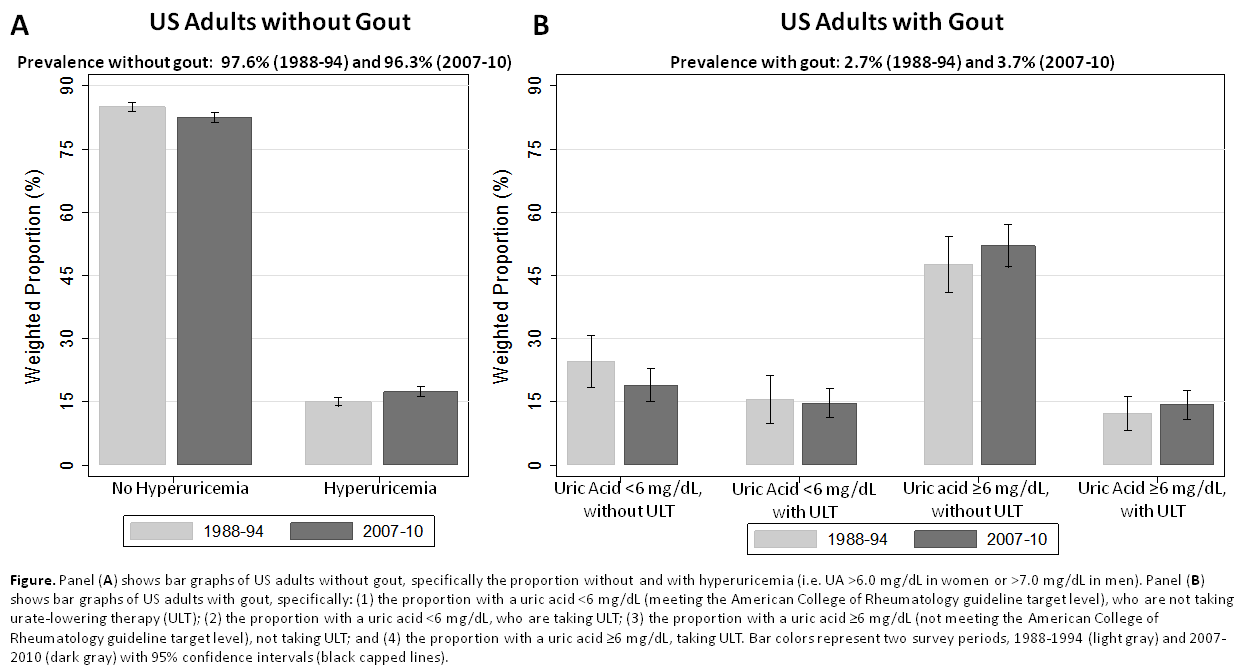Session Information
Session Type: Abstract Submissions (ACR)
The Treatment of Gout in Relation to the 2012 Uric Acid Target Guidelines in the US Population
Background/Purpose: Gout is a debilitating form of arthritis mediated by elevated serum uric acid (SUA) levels. Pharmacologic interventions to prevent recurrent gout are largely focused on urate-lowering therapy (ULT). In 2012, the American College of Rheumatology (ACR) released gout management guidelines encouraging providers to target a SUA <6 mg/dL. The proportion of US adults with gout undergoing ULT, in relation to this SUA target, is unknown. Further, while gout risk factors are well-characterized, demographic and clinical factors associated with a SUA above target have not been determined.
Methods: We examined the National Health and Examination Survey (NHANES), in the 1988-1994 and 2007-2010 survey periods. Participants <20 years or those missing data for SUA, ULT use, or gout status were excluded. Gout status was based on self-report of a physician (or health professional) diagnosis. According to the recent ACR gout treatment guidelines, a SUA above target in participants with gout was defined as a SUA ≥6.0 mg/dL in both men and women. Demographic and clinical factors associated with a SUA above target among NHANES participants with gout, were analyzed using adjusted and weighted Poisson regression.
Results: There were 15,505 NHANES participants in 1988-1994 and 10,977 in 2007-2010, among whom 443 and 514 had gout, respectively. The prevalence of gout rose from 2.7% in 1988-1994 to 3.7% in 2007-2010. In 2007-2010, the mean age was 48 years; 52% were female, 69% were white, 10% were black, and 8% were Mexican American. Notably, 66% of US adults with gout in 2007-2010 had a UA ≥6 mg/dl (Figure); among this hyperuricemic subgroup, 79% were not using ULT. In both time periods, higher BMI (prevalence ratio: 1.02 per 1 kg/m2; 95% CI: 1.00, 1.03; P = 0.02) and ULT (prevalence ratio: 0.56; 95% CI: 0.45, 0.70; P <0.001) were associated with a SUA above target (Table). Male sex, reduced glomerular filtration rate (eGFR), low HDL cholesterol, and diuretic use were significantly associated with a SUA above target in a least one time period.
Conclusion: The majority of US adults with gout had a SUA above the ACR target level and were not taking ULT. This study establishes a meaningful baseline to assess the effectiveness of ACR treatment guidelines for lowering UA in coming years.
|
Table. Demographic and clinical factors associated with a uric acid level above target (≥6 mg/dL) among US adults with gout. |
||||||||||
|
1988-94 (N with gout = 443) |
2007-10 (N with gout = 514) |
|||||||||
|
Prevalence Ratio (95% CI)* |
P |
Prevalence Ratio (95% CI)* |
P |
|||||||
|
Age, per 10 yrs |
1.01 (0.91, 1.11) |
0.92 |
0.99 (0.90, 1.10) |
0.91 |
||||||
|
Male |
1.31 (0.95, 1.81) |
0.10 |
1.87 (1.51, 2.30) |
<0.001 |
||||||
|
Race/Ethnicity |
||||||||||
|
Non-Hispanic white |
1.0 (reference) |
– |
1.0 (reference) |
– |
||||||
|
Non-Hispanic black |
1.19 (0.97, 1.44) |
0.09 |
0.83 (0.69, 1.01) |
0.06 |
||||||
|
Mexican American |
1.11 (0.78, 1.59) |
0.56 |
0.90 (0.74, 1.11) |
0.31 |
||||||
|
Body mass index per 1 kg/m2 |
1.02 (1.01, 1.03) |
<0.001 |
1.02 (1.00, 1.03) |
0.02 |
||||||
|
eGFR < 60 mL/min per 1.73m2 |
1.43 (1.13, 1.81) |
<0.001 |
1.17 (1.00, 1.37) |
0.06 |
||||||
|
Low HDL cholesterol |
0.97 (0.77, 1.21) |
0.77 |
1.25 (1.03, 1.51) |
0.03 |
||||||
|
Urate-lowering therapy† |
0.55 (0.40, 0.76) |
<0.001 |
0.56 (0.45, 0.70) |
<0.001 |
||||||
|
|
Diuretic medications |
1.32 (1.05, 1.64) |
0.02 |
|
1.20 (0.97, 1.47) |
0.09 |
||||
|
*All models were adjusted for age, sex (vs. female), race/ethnicity (vs. non-Hispanic white), body mass index, eGFR < 60 mL/min per 1.73m2 (vs. eGFR ≥ 60 mL/min per 1.73m2), low high density lipoprotein cholesterol (vs. elevated high density lipoprotein cholesterol), elevated total cholesterol (vs. low total cholesterol), hypertension (vs. no hypertension), diabetes (vs. no diabetes), no urate lowering therapy (vs. urate lowering therapy), diuretic use (vs. no diuretic medication use), and alcohol use (vs. never drank alcohol). Clinical factors that were not significant in either survey period (i.e. total cholesterol, hypertension, diabetes, and alcohol use) were not shown. |
||||||||||
|
†Allopurinol, probenecid, sulfinpyrazone, or combination colchicine-probenecid |
||||||||||
Disclosure:
S. Juraschek,
NIH,
2;
L. Kovell,
None;
E. Miller III,
None;
A. C. Gelber,
None.
« Back to 2013 ACR/ARHP Annual Meeting
ACR Meeting Abstracts - https://acrabstracts.org/abstract/the-treatment-of-gout-in-relation-to-the-2012-uric-acid-target-guidelines-in-the-us-population/

